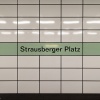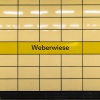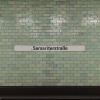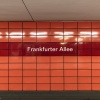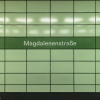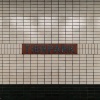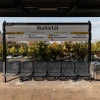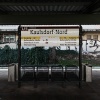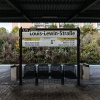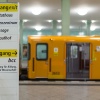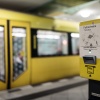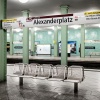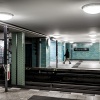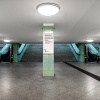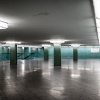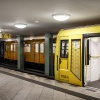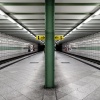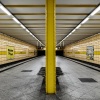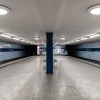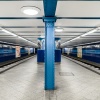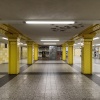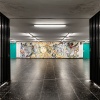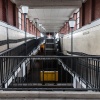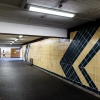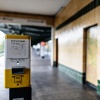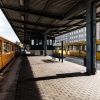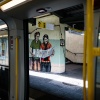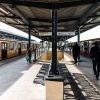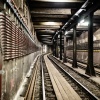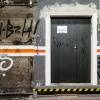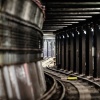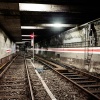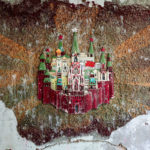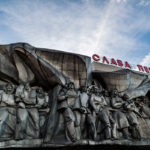Moving from West to East – The U5 Line
Why did the U5 run once in West Berlin and what does a Swede have to do with pre-war Berlin? Why do the stations of today’s U5 appear similar and functional? What role played the GDR and what does the U5 have to do with Klaus Wowereit’s still unfinished BBI airport desaster? Like all other also the fifth BVG underground line is unique but also prompts a couple of questions. Its highlight is Alexanderplatz, an underground cathedral from where in the future U5 will extend to join forces with the U55 to finally shake hands with the central train station infrastructure-wise. Reflecting the history of that line one thing becomes apparent: Money played the most important role in life of the U5.
BER – Klaus Wowereit’s airport that laid us open to worldwide ridicule, that brought us wonderfully skyrocketing costs and that ruined companies already having moved into the airport building. But enough complaints. You are right Klaus, those things are never a politician’s fault and you’ve underlined that attitude with your Kim Jong Un-like resignation resistance. And your head of the airport Hartmut Mehdorn is no saviour, he’s rather a Grim Reaper. So let’s have a look if and when BER airport will finally start operations, or if BVG has to revive the once discarded further planning of extending the U5 route to the west connecting to (operating!) Tegel Airport.
But let’s get back to people being able to accomplish missions, to construction projects and the U5, that actually could also be called “Grenander Rail” as it was that Swedish architect who left his mark on the U5 and not the ever bad Communists. In the 1920’s he developed a template for underground stations that got used extensively when extending the route between Alexanderplatz and Friedrichsfelde. Back then Friedrichsfelde was more or less unsettled and an ideal place for a depot.
Grenander’s Scandinavian minimal standard stations differ in subtle nuances only. Only the station colour and minor details make the differences in the world of Grenander’s IKEA-like underground stations. Well, luckily back then they never ran out of fitting screws as well as glue and things didn’t collapse after first assembly. However, Grenander’s standard stations provide some very nice symmetric perspectives.
Things get different at Alexanderplatz. Its pedestrian tunnels all being coloured with turquoise tiles form an underground cathedral where between three different BVG lines can be changed. Due to people frequenting this station very well it needs patience to capture a photo without humans on it as the trains of brown U5, orange U2 and blue U8 release plenty of them into the underground of Berlin’s eastern city centre.
Already at the end of the 19th century the alley Frankfurter Allee developed to become busy part of Berlin. Hence quickly ideas arose to make this aorta being accessible by an underground train connection. Those plans got put into practice in the 1920’s but like the constructions works going on for the U8 line, the U5 quickly felt the global economic crisis. No money = no construction progress. U5 could start operations in 1930, one year before Alfred Grenander died, only due to workers having been transferred from other construction sites to finish the tunnel, stations and rails leading to Friedrichsfelde.
GDR got involved not before the 1970’s, when it planned to continue the U5 from its former terminus Friedrichsfelde to Hönow, a suburban town of Berlin. The Communists wanted to connect the newly developed settlement area of Hellersdorf infrastructurally to the city and its centre. Being faced with financial problems again, GDR engineers decided to let the major part of the new U5 run on the surface, at daylight and not to extend the tunnel.
That makes Tierpark being the only underground station being constructed when East Germany was under Communist regency. The actual construction works began in 1985 and got finished shortly before the fall of the Berlin Wall. Nowadays U5 includes 20 stations and measures 18.4 kilometres. The suburban town of Hönow got incorporated into the city of Berlin in 1990, making the Hönow-based storage sidings becoming a Berlin and not Brandenburg thing.
A truly unique construct, for Berlin and Eastern Germany, is Wuhletal station as its platforms connect the underground directly with the S-Bahn. Passengers can directly change between both rail systems. The only other construct of this kind can be found in Frankfurt am Main. People being eager to arrive Alexanderplatz the fastest way can change from the U to the S (line 5, to be precise) as it outspeeds the U5 by 1 minute. However, we Berliners know about the quality of our problem child number one the S-Bahn, a victim of Hartmut Mehdorn.
The U5 already had a life before the Fall of the Berlin Wall when it connected the U2 station Deutsche Oper with U7 station Richard-Wagner-Platz as small profile rail. From 1966 until 1970 that short section was in operation as U5. In cooperation and with permission of BVG I am allowed to show you exclusive photos of that tunnel system. To people being interested in such constructional as well as historical witnesses of past times I recommend the tunnel walks organised by AG Berliner U-Bahn association (www.ag-berliner-u-bahn.de)


